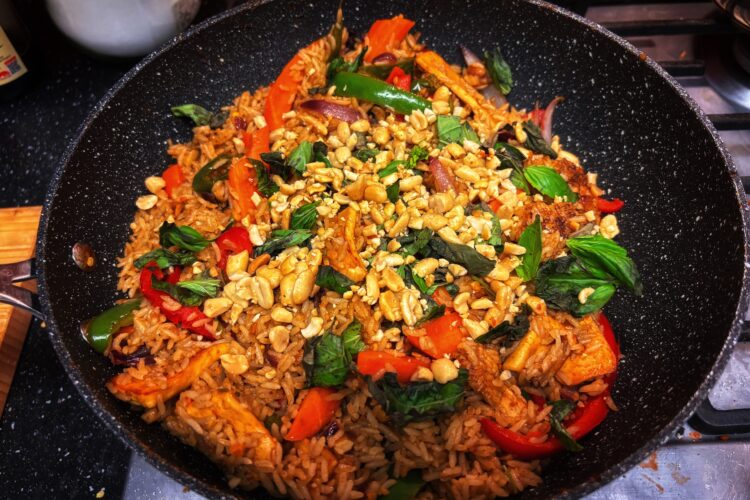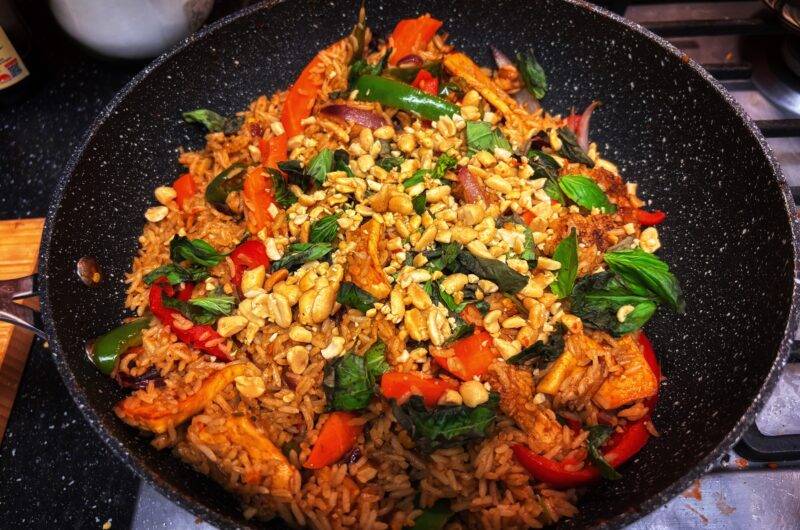This vibrant Thai basil fried rice recipe packs bold restaurant-style flavors while brimming with protein and essential nutrients
Skip to the section you need
Introduction to the Thai Basil Fried Rice Recipe
Thai dishes pack boldness, freshness, spice and a distict caramelised sweetness, all in a single dish. However, Thai restaurants don’t seem like the healthiest of alternatives! Also, most of the average neighbourhood Thai places barely cater to vegetarian and vegan needs. Therefore, here we have this bold and flavoursome Thai Basil fried rice that is not only vegan but also offers the goodness of protein (from paneer or tofu and the peanuts), vitamins and minerals.
Thai Food: A culinary history
Thai food has been known for seasonal and fresh ingredients and a variety of sea food. Being an agrarian economy with a long coastline, Thai dishes are famous for the use of fresh (as opposed to dried) herbs, balanced spices and lean meats. Thailand was a major hub in the East West trade. Therefore, Thai cuisine gained and grew from influences all around the world. While the most popular influences are from Indian, Chinese and Portuguese cuisines, Thai food also has roots in French, Persian, Cambodian and Arabic cuisines.
The carrot flowers and vegetable carving we see at Thai restaurants today is no marketing gimmick. The art of vegetable carving originated in the Sukhothai kingdom about 700 years ago and has been a staple of Thai plating ever since.
Despite Thailand being a relatively small country, it is rich with regional cuisines and variations. Rice and rice-based noodles are staples. However, what is surprising is the way we know and enjoy Thai cuisine around the world.
Origins of the Thai Basil Fried rice
Thailand was one of the earliest countries to launch programs like ‘Kitchen of the World’ and ‘Global Thai’. These programs led to the ‘Thai Select’ certification for restaurants overseas. This culinary diplomacy resulted in standardised dishes that are found in every Thai restaurant around the world.
Modern Thai dishes like the Thai Basil Fried Rice and Pad Thai noodles are a product of this program, rather than the rich 1000 year history of the Thai cuisine. While this might all seem like we are being subjected to unauthentic food, the fact remains that these dishes were carefully perfected and marketed to give the rest of the world a taste of the wonderful Thai cuisine.
Also, let’s face it, this structured program has given us a sampler of the entirety of Thailand, unlike other cuisines, where we tend to barely touch the tip of the iceberg. Therefore, the Thai basil fried rice, albeit being vegetarian, is a fair and unblemished representation of the Thai cuisine.
With that out of the way, let us enjoy this flavour bomb!
Thai Basil Fried Rice: What you need
The componets for this Thai Basil fried rice include well-made and perfectly fluffy long-grain rice, tofu (cold-marinated in vegetarian oyster sauce) or paneer caramelised in veggie oyster sauce, a flavourful Thai sauce and an aromatic base. You can add veggies of choice to your Thai basil fried rice. I love adding carrots, red bell peppers, white onion, mung bean sprouts and Chinese broccoli. However, you can use any other vegetables you have in your fridge. I have tried broccoli, zucchini (courgettes), parsnips, cabbage, and snow peas with wonderful results.
I love garnishing this Thai basil fried rice with roughly powdered salted and roasted peanuts, fresh Thai basil leaves and coriander.
How to source ingredients for the Thai Basil Fried Rice
The special flavour in this Thai basil fried rice comes from the sauce. The main ingredient for the sauce is Tao Jiew, a soy paste commonly known as Thai miso. I love the Healthy Boy Tao Jiew available easily on Amazon or in most Asian grocery stores. I swear by the Lee Kum Kee Mushroom Vegetarian Oyster Sauce (and quite frankly, most of the other Asian sauces from the Lee Kum Kee range). I buy my peanut butter in bulk from Waitrose & Partners but surprisingly, I also buy my palm sugar from there. However, if you use a lot of palm sugar or have many more members in the family, you can get a large pack of Palm Sugar from most Asian grocery stores or from Amazon.
For the rice
1.5 cups (~475 ml worth) Jasmine rice or Basmati rice (rice cooked the day before and stored in the fridge works best; however, you can also make fresh rice and let it cool fully before adding it to the fried rice)
For the aromatic base
🔸 2 shallots, finely chopped
🔸 4 tbsp chopped coriander stems
🔸 7-8 cloves garlic, finely chopped
🔸 2.5 tsp palm sugar (or fine brown sugar)
🔸 2 Thai Bird’s Eye chilies, finely chopped (add more for higher heat)
🔸 1.5 tbsp coriander powder
🔸 ½ tsp cumin powder
For the Thai Sauce (optionally, prep in advance)
🔸 4 tbsp Thai miso (Tao Jiew)
🔸 3 tbsp soy sauce (I use Chinese light soy sauce because it is quite similar to Thai soy sauce)
🔸 1.5 tbsp plain peanut butter
🔸 1 tsp palm sugar (or fine brown sugar)
🔸 ½-1 tsp vegan fish sauce (optional; this is quite salty and you might want to use it sparingly if you are new to this ingredient)
For the protein (prep the tofu at least 24 hours in advance)
🔸 200 g extra firm tofu or 200 g paneer
Added veggies
🔸 2 carrots, chopped into 2-inch batons
🔸 1 red bell pepper, julienned
🔸 ½ white onion, julienned
Thai Basil Fried Rice: Managing Dietary Requirements
This recipe is naturally vegan. Use tofu instead of paneer as your source of protein to keep it vegan.
Make it gluten-free: You specifically need to source gluten-free soy sauce as traditional Chinese soy sauce is made using wheat as an ingredient. The same is applicable for vegan fish sauce. Veggie oyster sauce may also contain traces of wheat so it is best to buy from a brand that specifically supplies gluten-free sauce. Certain brands like Lee Kum Kee offer gluten-free alternatives for most of these sauces. Finally, do note that Tao Jiew always contains wheat. You can substitute this 1:1 with white miso. Gluten-free miso is available in most supermarkets.
Make it nut-free: If you are allergic to nuts, this might not be the most suitable recipe. This is because most Asian condiments have cross-contamination with peanuts. However, if you can find nut-free vegan fish sauce, oyster sauce, Tao Jiew and soy sauce, you can make this recipe completely nutfree by using sunflower butter instead of peanut butter. Skip the garnish with roasted and salted peanuts. Instead, you can garnish with lightly roasted pumpkin and sunflower seeds.
Thai Basil Fried Rice Recipe
1️⃣ Prepare the rice
Rinse 1.5 cups of rice well. You want to rinse the rice till the water is clear. While the standard method to rinse the rice is to add rice and water to a bowl, swish it with your hands and drain repeatedly, I love to rinse using only a colander. Let water course through rice resting on the colander. Swish your hands through the rice repeatedly. Do this for 3-4 minutes and you would have rinsed your rice perfectly.
The pressure cooker method: Add 2 cups of water for 1 cup of rice (therefore 3 cups of water for 1.5 cups of rice). Seal the pressure cooker and wait till the valve releases steam. Once you see a steady stream of steam, seal the valve using the cooker weight. Wait for 3 whistles then take the cooker off the hear. Finally, let the cooker release pressure naturally.

The stovetop method: Add 1.25 cups water for 1 cup of rice (1.8-1.9 cups of water for 1.5 cups of rice). Bring the water to simmer on high heat. Once it simmers completely, turn the flame to low. Now, cover and cook for 10 minutes. Turn off the heat and let it stand for 5-10 minutes. Finally, uncover and fluff the rice with a spatula.
The instant pot method: I recommend using the instant pot only to cook rice in large quantities. In an instant pot, use a 1:1 ratio of rice and water. Use the instant pot to cook the rice for 5-6 minutes on high pressure. Let the pressure release naturally.
2️⃣ Prepare the Thai Sauce (make it in bulk, recipe here)
This is something you can make in bulk and store for up to a month in the refrigerator. For this particular recipe, add 4 tbsp Tao Jiew to a bowl. Mash the beans with the back of your fork. Once they are almost mashed, add the 3 tbsp soy sauce, chopped chilies, palm sugar, vegan fish sauce, and peanut butter. Mix well till the peanut butter mixes with the rest of the ingredients to form a slurry.
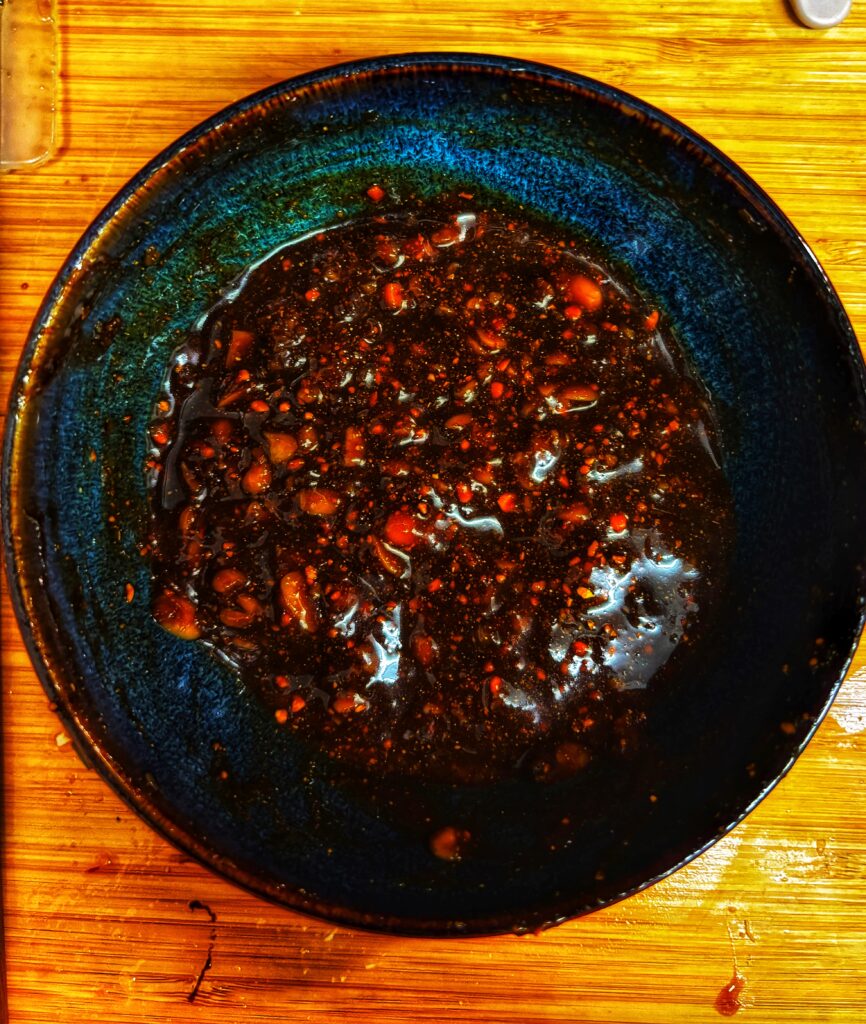
3️⃣ Prepare the protein (prep the tofu at least 24 hours in advance)
This step depends on whether you are using paneer or tofu. Thinly slice 200 g of your chosen protein.
If you are using tofu: Add the tofu to an airtight container with 4 tbsp oyster sauce. Combine well and marinate it in the refrigerator for at least 2 hours. This lets the tofu absorb the umami-rich flavours of the vegetarian oyster sauce.
If you are using paneer: Heat a pan 2 tsp of neutral oil (I use olive oil). Brush the oil well to spread it evenly on the pan. Add the thinly sliced paneer and 4 tbsp oyster sauce. Cook on a high heat and flip every 2-3 minutes to ensure all the sides are well caramelised.

4️⃣ Prepare the veggies
Cut the carrots into batons and the onions and bell peppers into long juliennes. Thinly slice or finely chop the garlic cloves. Chop the coriander stems in to ½ inch pieces. Finely chop the shallots.
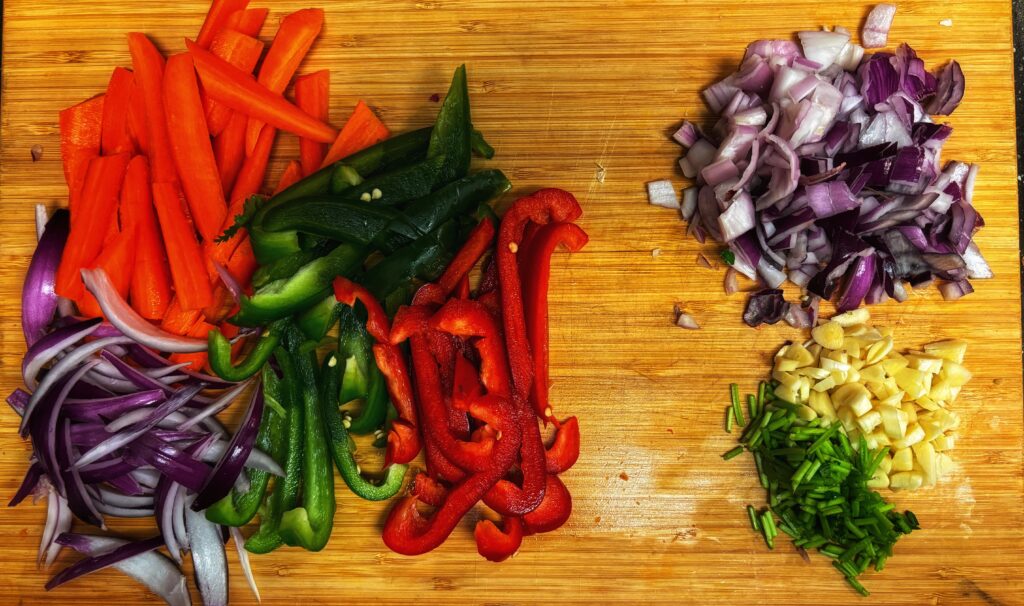
5️⃣ Get the base ready
Now, add 2 tbsp neutral oil to a pan. Once the oil heats, add shallots, chopped chillies and the coriander stems. Once the shallots turn translucent, add the finely chopped garlic cloves.
Finally, add the cumin powder, coriander powder and palm sugar. Take the base off the heat once the base is caramelised and brown.
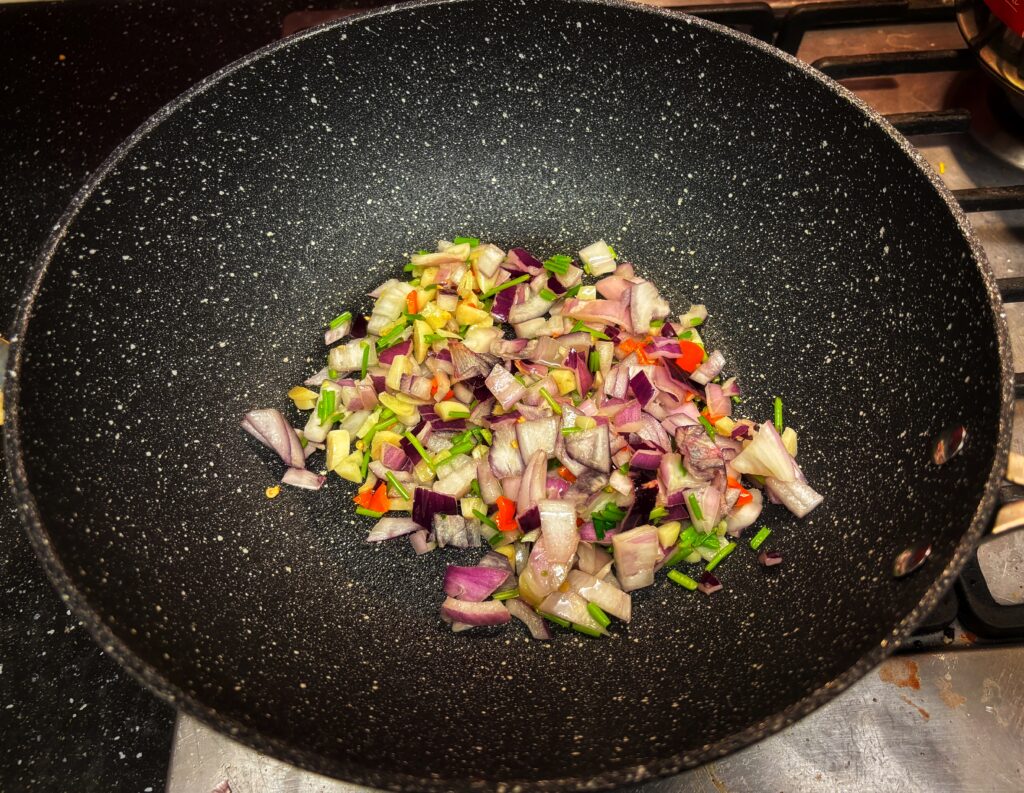
6️⃣ Add the veggies and protein
To the base, add the paneer or tofu. Then add the carrots, onion and bell peppers. Finally, add the Thai sauce and combine well. Add salt to taste, if required.
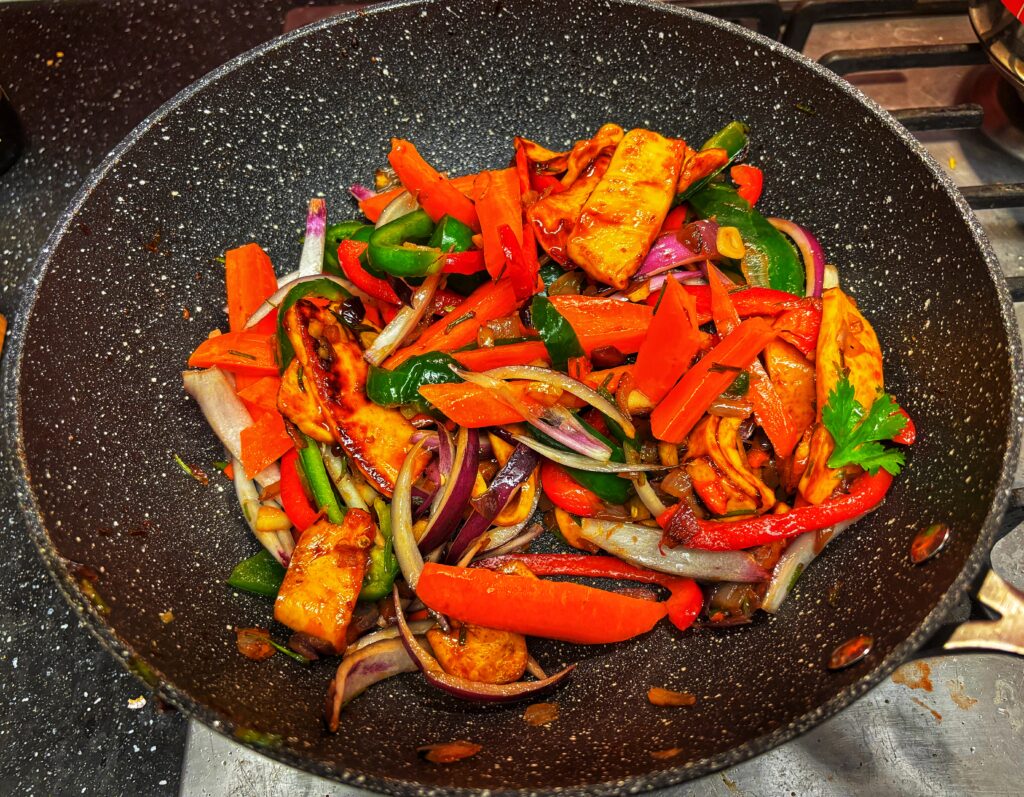
7️⃣ Complete the Thai Basil Fried Rice
Add rice in batches to the combined base, tofu or paneer and, the veggies. Break the rice with a spatula to ensure there are no lumps. Combine well.
8️⃣ Garnish and serve
Tear 10-12 Thai basil leaves with your hands. Tearing basil leaves with your hands ensures that none of the oils and juices are lost. This preserves the taste.
Roughly chop up 4-5 tbsp of salted and roasted peanuts.
Chop up 1-2 tsp of coriander leaves.
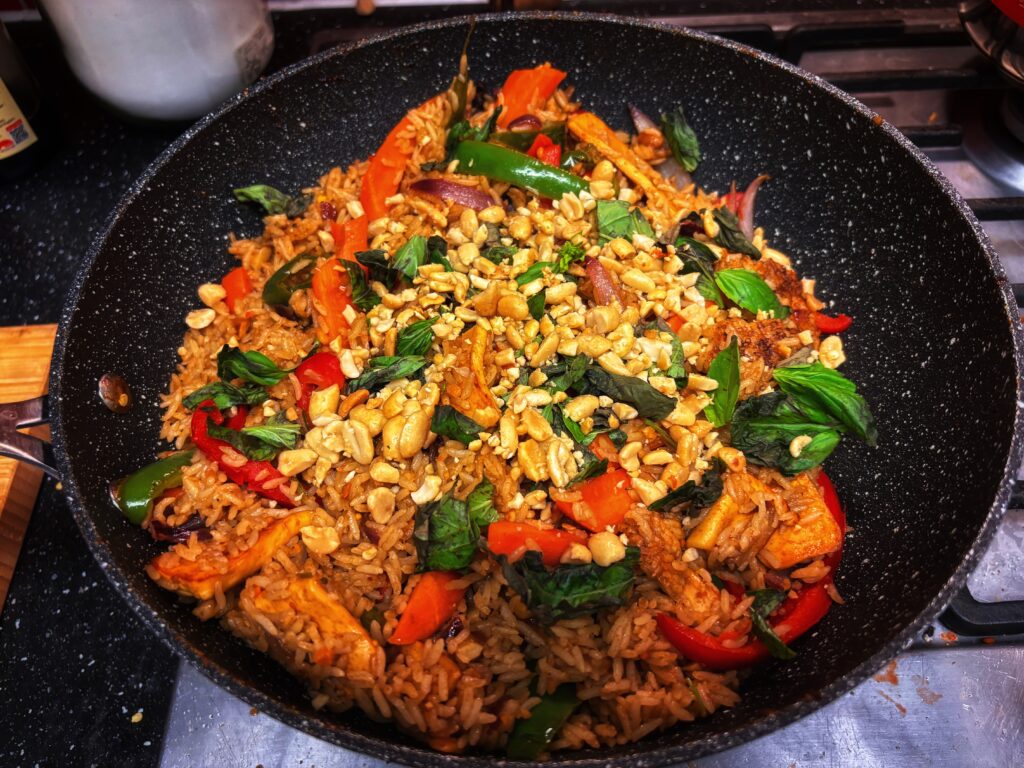
Gsrnish the rice with all these toppings. You can optionally add Thai chili oil to amp up the spice. Enjoy it fresh or pack it in an airtight container for a takeaway work lunch.
Thai Basil Fried Rice: 30-min supercharged dinner
Course: MainCuisine: ThaiDifficulty: Medium4
servings15
minutes15
minutes300
kcalIngredients
- For the base
2 shallots, finely chopped
4 tbsp chopped coriander stems
7-8 cloves garlic, finely chopped
2.5 tsp palm sugar (or fine brown sugar)
2 Thai Bird’s Eye chilies, finely chopped (add more for higher heat)
1.5 tbsp coriander powder
½ tsp cumin powder
- For the Thai sauce
4 tbsp Thai miso (Tao Jiew)
3 tbsp soy sauce (I use Chinese light soy sauce because it is quite similar to Thai soy sauce)
1.5 tbsp plain peanut butter
1 tsp palm sugar (or fine brown sugar)
½-1 tsp vegan fish sauce (optional; this is quite salty and you might want to use it sparingly if you are new to this ingredient)
- Rice & Protein
1.5 cups (~475 ml worth) Jasmine rice or Basmati rice (rice cooked the day before and stored in the fridge works best; however, you can also make fresh rice and let it cool fully before adding it to the fried rice)
200 g extra firm tofu or 200 g paneer
- Added Veggies
2 carrots, chopped into 2-inch batons
1 red bell pepper, julienned
½ white onion, julienned
Directions
- Prepare the rice
Rinse 1.5 cups of rice well. You want to rinse the rice till the water is clear. While the standard method to rinse the rice is to add rice and water to a bowl, swish it with your hands and drain repeatedly, I love to rinse using only a colander. Let water course through rice resting on the colander. Swish your hands through the rice repeatedly. Do this for 3-4 minutes and you would have rinsed your rice perfectly.
The pressure cooker method: Add 2 cups of water for 1 cup of rice (therefore 3 cups of water for 1.5 cups of rice). Seal the pressure cooker and wait till the valve releases steam. Once you see a steady stream of steam, seal the valve using the cooker weight. Wait for 3 whistles then take the cooker off the hear. Finally, let the cooker release pressure naturally.
The stovetop method: Add 1.25 cups water for 1 cup of rice (1.8-1.9 cups of water for 1.5 cups of rice). Bring the water to simmer on high heat. Once it simmers completely, turn the flame to low. Now, cover and cook for 10 minutes. Turn off the heat and let it stand for 5-10 minutes. Finally, uncover and fluff the rice with a spatula.
The instant pot method: I recommend using the instant pot only to cook rice in large quantities. In an instant pot, use a 1:1 ratio of rice and water. Use the instant pot to cook the rice for 5-6 minutes on high pressure. Let the pressure release naturally. - Prepare the Thai Sauce
This is something you can make in bulk and store for up to a month in the refrigerator. For this particular recipe, add 4 tbsp Tao Jiew to a bowl. Mash the beans with the back of your fork. Once they are almost mashed, add the 3 tbsp soy sauce, chopped chilies, palm sugar, vegan fish sauce, and peanut butter. Mix well till the peanut butter mixes with the rest of the ingredients to form a slurry. - Prepare the protein (prep the tofu at least 24 hours in advance)
This step depends on whether you are using paneer or tofu. Thinly slice 200 g of your chosen protein.
If you are using tofu: Add the tofu to an airtight container with 4 tbsp oyster sauce. Combine well and marinate it in the refrigerator for at least 2 hours. This lets the tofu absorb the umami-rich flavours of the vegetarian oyster sauce.
If you are using paneer: Heat a pan 2 tsp of neutral oil (I use olive oil). Brush the oil well to spread it evenly on the pan. Add the thinly sliced paneer and 4 tbsp oyster sauce. Cook on a high heat and flip every 2-3 minutes to ensure all the sides are well caramelised. - Prepare the veggies
Cut the carrots into batons and the onions and bell peppers into long juliennes. Thinly slice or finely chop the garlic cloves. Chop the coriander stems in to ½ inch pieces. Finely chop the shallots. - Get the base ready
Now, add 2 tbsp neutral oil to a pan. Once the oil heats, add shallots, chopped chillies and the coriander stems. Once the shallots turn translucent, add the finely chopped garlic cloves.
Finally, add the cumin powder, coriander powder and palm sugar. Take the base off the heat once the base is caramelised and brown. - Add the veggies and protein
To the base, add the paneer or tofu. Then add the carrots, onion and bell peppers. Finally, add the Thai sauce and combine well. Add salt to taste, if required. - Complete the Thai Basil Fried Rice
Add rice in batches to the combined base, tofu or paneer and, the veggies. Break the rice with a spatula to ensure there are no lumps. Combine well. - Garnish and serve/pack
Tear 10-12 Thai basil leaves with your hands. Tearing basil leaves with your hands ensures that none of the oils and juices are lost. This preserves the taste.
Roughly chop up 4-5 tbsp of salted and roasted peanuts.
Chop up 1-2 tsp of coriander leaves.
Gsrnish the rice with all these toppings. You can optionally add Thai chili oil to amp up the spice. Enjoy iy fresh or pack it in an airtight container for a takeaway work lunch.
Notes
- This Thai basil fried rice can be stored easily. Store it in an airtight container in the refrigerator for up to a week.
- The Thai sauce used in the recipe is great for bulk cooking. Store it in the refrigerator for up to a month in an airtight container.
- If you are allergic to nuts, this might not be the most suitable recipe. This is because most Asian condiments have cross-contamination with peanuts. However, if you can find nut-free vegan fish sauce, oyster sauce, Tao Jiew and soy sauce, you can make this recipe completely nutfree by using sunflower butter instead of peanut butter. Skip the garnish with roasted and salted peanuts. Instead, you can garnish with lightly roasted pumpkin and sunflower seeds.
To enjoy Thai food similar to the one at your local takeaway, try the 30-minute Pad Thai Noodles recipe. Bonus: it uses the Thai sauce that we made in this recipe!
If you loved this recipe and want something quick using ingredients from supermarkets, try out this Thai-inspired 30-minute Silky Coconut Mushroom Soup.
Be sure to share what veggies you used and whether you enjoyed this Thai Basil Fried Rice recipe in the comments below!

